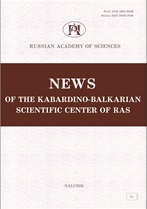|
COMPUTER SCIENCE. CALCULATION EQUIPMENT. MANAGEMENT
Multiagent model of perceptual space formation
in the process of mastering linguistic competence
Z. V. Nagoeva, I. A. Gurtuevab, K. Ch. Bzhikhatlova
a Federal state budgetary scientific establishment "Federal scientific center
"Kabardin-Balkar Scientific Center of the Russian Academy of Sciences",
360002, KBR, Nalchik, 2, Balkarov street
b Institute of Computer Science and Problems of Regional Management –
branch of Federal public budgetary scientific establishment "Federal scientific center
"Kabardin-Balkar Scientific Center of the Russian Academy of Sciences",
360000, KBR, Nalchik, 37-a, I. Armand St.
Abstract:
The model of the early development of language competencies proposed in this paper, takes into account the social factors effects. It is a simulation model of phonemic imprinting. The model describes the process of perceiving audio stimuli as their mapping into classes of elementary language units. The machine learning algorithm was developed using the results of the study of speech addressed to children. Our model will allow to explore the features of phonetic perception, the cognitive mechanisms that underlie language development, highlight the main factors affecting the duration of the plasticity period. The proposed model gives possibilities to build perceptual maps, design diagnostic tools to describe and study the sensitive period. The model can also be used to create speech systems that are resistant to various influences and effective when used in conditions of high noise.
Keywords:
multiagent systems, artificial intelligence, artificial neuron nertworks, speech recognition, plasticity period, motherese.
Received: 08.06.2020
Citation:
Z. V. Nagoev, I. A. Gurtueva, K. Ch. Bzhikhatlov, “Multiagent model of perceptual space formation
in the process of mastering linguistic competence”, News of the Kabardino-Balkarian Scientific Center of the Russian Academy of Sciences, 2020, no. 3, 13–22
Linking options:
https://www.mathnet.ru/eng/izkab127 https://www.mathnet.ru/eng/izkab/y2020/i3/p13
|


| Statistics & downloads: |
| Abstract page: | 69 | | Full-text PDF : | 52 | | References: | 14 |
|



 Contact us:
Contact us: Terms of Use
Terms of Use
 Registration to the website
Registration to the website Logotypes
Logotypes